Field Tests on Eco-Friendly Railway Precast Concrete Slab
Abstract
:1. Introduction
2. B2S Panel
3. Field Test Set-Up
Installation of the B2S Panels
4. Field Test Results
4.1. Dynamic Wheel Loads
4.2. Rail Displacements and Track Stiffness
4.3. Rail Bottom Stress
4.4. Accelerations and Noise
5. Conclusions
Author Contributions
Funding
Conflicts of Interest
References
- Oden, C.P.; Ho, C.L.; Kashani, H.F.; Smith, S.S. Ballast Fouling Measurement Tool: Phase 1; ORD 18-33; Federal Railroad Administration: Washington, DC, USA, 2018. [Google Scholar]
- Brown, M.; Li, D. Ground Penetrating Radar Technology Evaluation and Implementation: Phase 2; DOT/FRA/ORD-18/33; Federal Railroad Administration: Washington, DC, USA, 2018. [Google Scholar]
- Tennakoon, N.; Indraratna, B.; Rujikiatkamjorn, C.; Nimbalkar, S.; Neville, T. The role of ballast-fouling characteristics on the drainage capacity of rail substructure. Geotech. Test. J. 2012, 35, 629–640. [Google Scholar] [CrossRef] [Green Version]
- National Transportation Safety Board Railroad Accident Brief: Metro-North Railroad Derailment; NTSB/RAB-14/12; National Transportation Safety Board: Washington, DC, USA, 2014.
- Riding, K.A.; Peterman, R.J.; Guthrie, S.; Brueseke, M.; Mosavi, H.; Koby, D. A Study of Environmental and Track Factors That Contribute to Abrasion Damage of Concrete Ties; DOT/FRA/ORD-19/38; Federal Railroad Administration: Washington, DC, USA, 2019. [Google Scholar]
- Chen, Z.; Shin, M.; Andrawes, B.; Edwards, J.R. Parametric study on damage and load demand of prestressed concrete crosstie and fastening systems. Eng. Fail. Anal. 2014, 46, 49–61. [Google Scholar] [CrossRef]
- Momeni, A.F.; Peterman, R.J.; Beck, B.T.; Wu, C.-H.J.; Bodapati, N.N.B. Effect of Concrete Release Strength on the Development Length and Flexural Capacity of Members Made with Different Prestressing Wires Commonly Used in Pretensioned Concrete Railroad Ties. In Proceedings of the 2015 Joint Rail Conference, ASME, San Jose, CA, USA, 23–26 March 2015. [Google Scholar]
- Yu, H.; Marquis, B.P.; Jeong, D.Y. Failure analysis of railroad concrete crossties in the center negative flexural mode using finite element method. Proc. Inst. Mech. Eng. Part F J. Rail Rapid Transit 2017, 231, 610–619. [Google Scholar] [CrossRef]
- Bastos, J.C.; Álvarez-Reyes, A.; Dersch, M.S.; Edwards, J.R.; Barkan, C.P.L. Laboratory Characterization of Structural Capacity of North American Heavy Haul Concrete Crossties. Transp. Res. Rec. J. Transp. Res. Board 2018, 2672, 116–124. [Google Scholar] [CrossRef]
- Shin, M.; Yu, H. Numerical Evaluation of Splitting Performance of Prestressed Concrete Prisms with Larger Diameter Prestressing Wires. In Proceedings of the 2019 Joint Rail Conference, ASME, Snowbird, UT, USA, 10–12 April 2019; p. V001T01A018. [Google Scholar]
- Bilow, D.; Randich, G. Slab track for the next 100 years. In Proceedings of the 2000 Annual Conference, American Railway Engineering and Maintenance-of-Way Association, Dallas, TX, USA, 10–13 September 2000; pp. 1–20. [Google Scholar]
- Esveld, C. Modern Railway Track. In Proceedings of the First International Conference on Road and Rail Infrastructure, Opatijia, Croatia, 17–18 May 2010. [Google Scholar]
- Lei, X.; Zhang, B. Analysis of dynamic behavior for slab track of high-speed railway based on vehicle and track elements. J. Transp. Eng. 2011, 137, 227–240. [Google Scholar] [CrossRef]
- Pichler, D.; Gmbh, P.B. Ballastless Track Systems Experiences Gained in Austria and Germany. In Proceedings of the AREMA Conference, Indianapolis, IN, USA, 29 September–2 October 2013; pp. 81–100. [Google Scholar]
- Tayabji, S.D.; Bilow, D. Concrete Slab Track State of the Practice. Transp. Res. Rec. 2001, 1742, 87–96. [Google Scholar] [CrossRef] [Green Version]
- Koh, T.; Shin, M.; Bae, Y.; Hwang, S. Structural performances of an eco-friendly prestressed concrete sleeper. Constr. Build. Mater. 2016, 102, 445–454. [Google Scholar] [CrossRef]
- Koh, T.; Shin, M.; Bae, Y.; Hwang, S. Experimental Study on transfer length of an eco-friendly prestressed concrete sleeper. Constr. Build. Mater. 2016, 109, 25–33. [Google Scholar] [CrossRef]
- Koh, T.; Hwang, S. Field Evaluation and Durability Analysis of an Eco-Friendly Prestressed Concrete Sleeper. J. Mater. Civ. Eng. 2015, 27, B4014009. [Google Scholar] [CrossRef]
- Kong, S.-Y.; Kim, S.-J.; Baik, C.-H. A Study of Optimum Thickness of B2S Track System under Variety of Rail support Stiffness and Axle load. In Proceedings of the 2009 Fall Conference of the Korean Society for Railway, Geongju, Korea, 13–14 November 2009; pp. 2685–2691. (In Korean). [Google Scholar]
- Kong, S.-Y.; Oh, H.-W.; Kim, S.-J. The Reduction of Structure-borne Noise in an Elevated Station (Changdong Station) of Seoul Metro Line No. 1–4. In Proceedings of the 2007 Spring Conference of the Korean Society for Railway, Jeju, Korea, 17–18 May 2007; pp. 27–32. (In Korean). [Google Scholar]
- Ministry of Land Infrastructure and Transportation. Performance Testing Specifications for Urban Railway Infrastructure; Ministry of Land Infrastructure and Transportation: Sejong City, Korea, 2013. [Google Scholar]


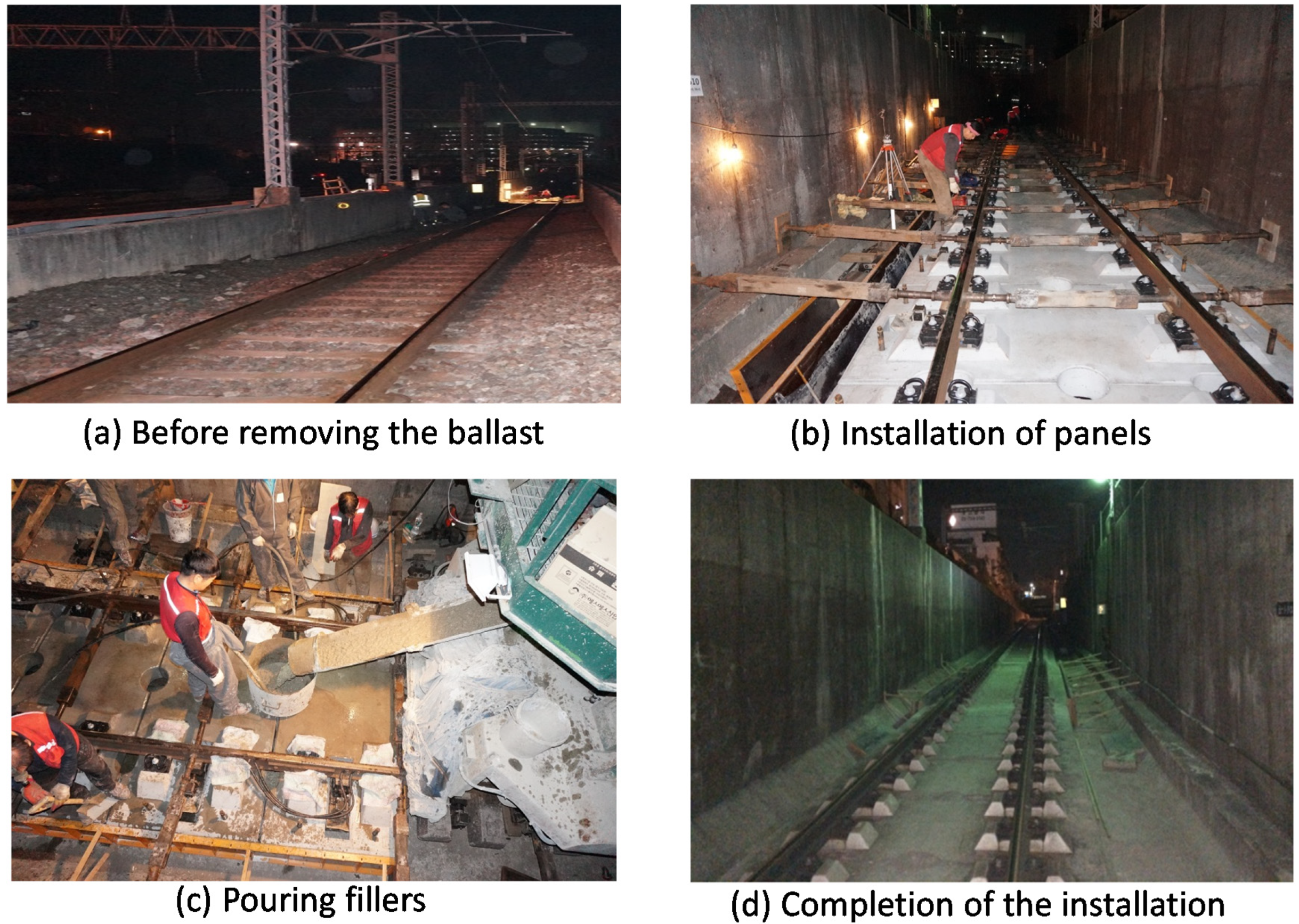




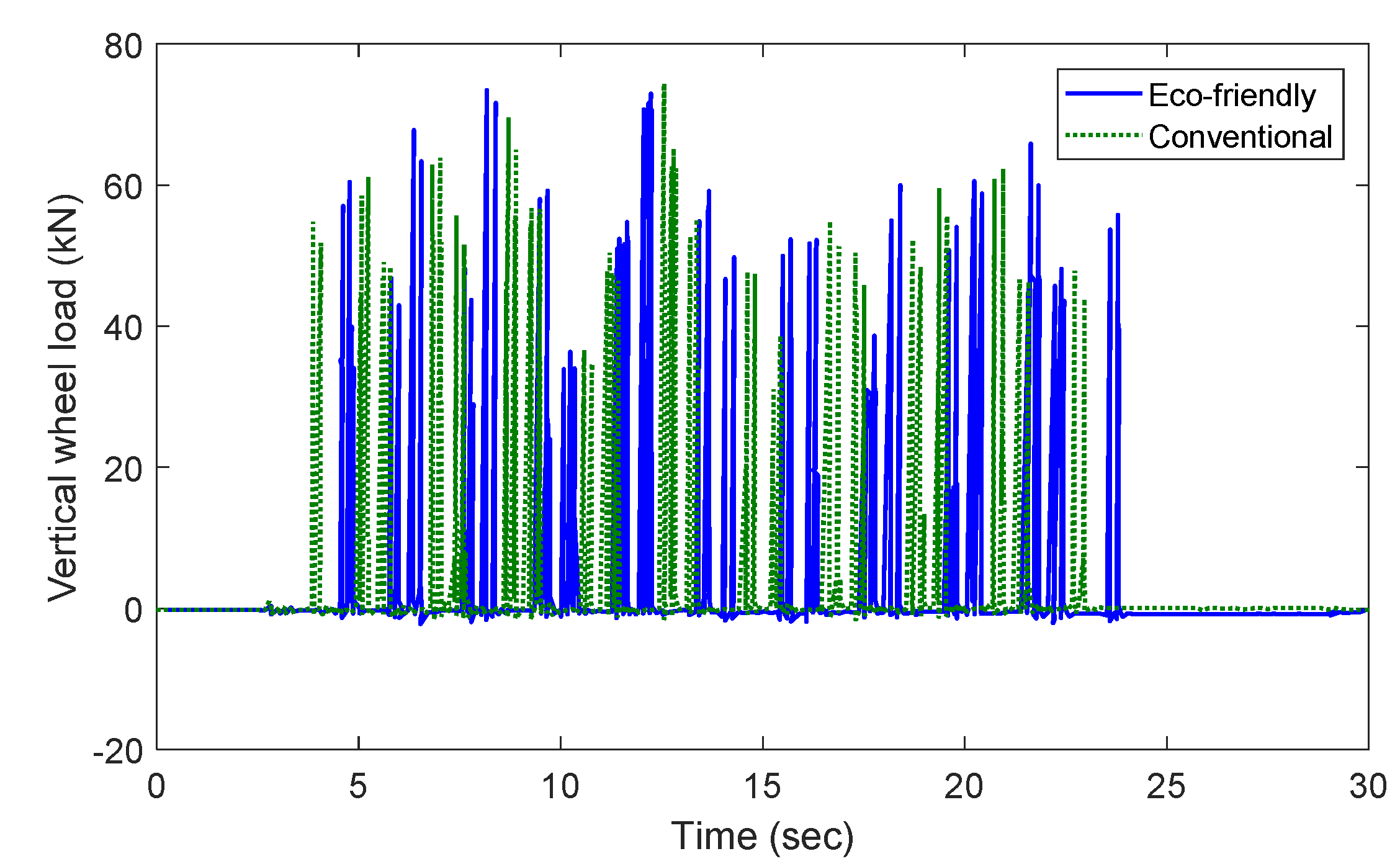
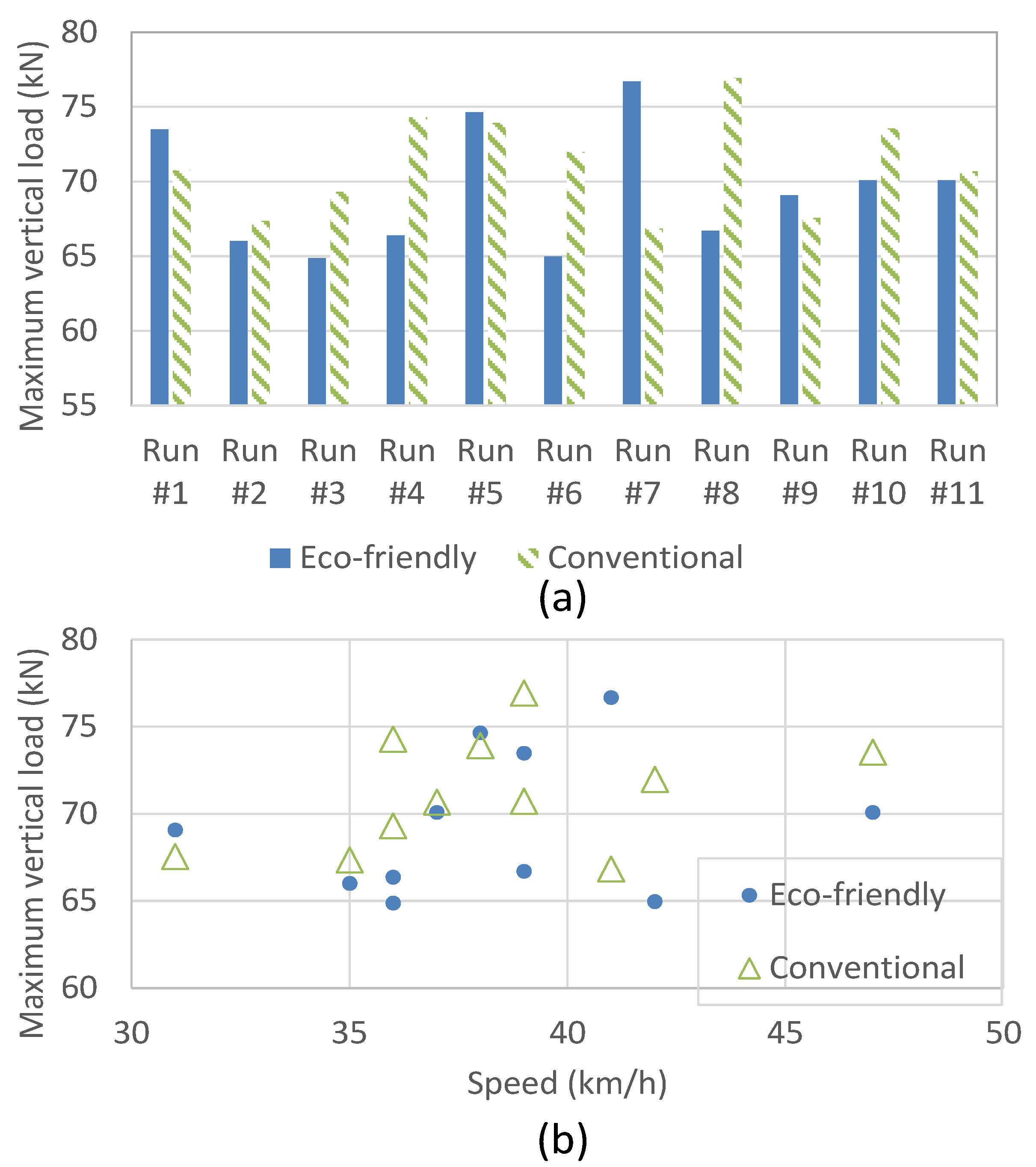
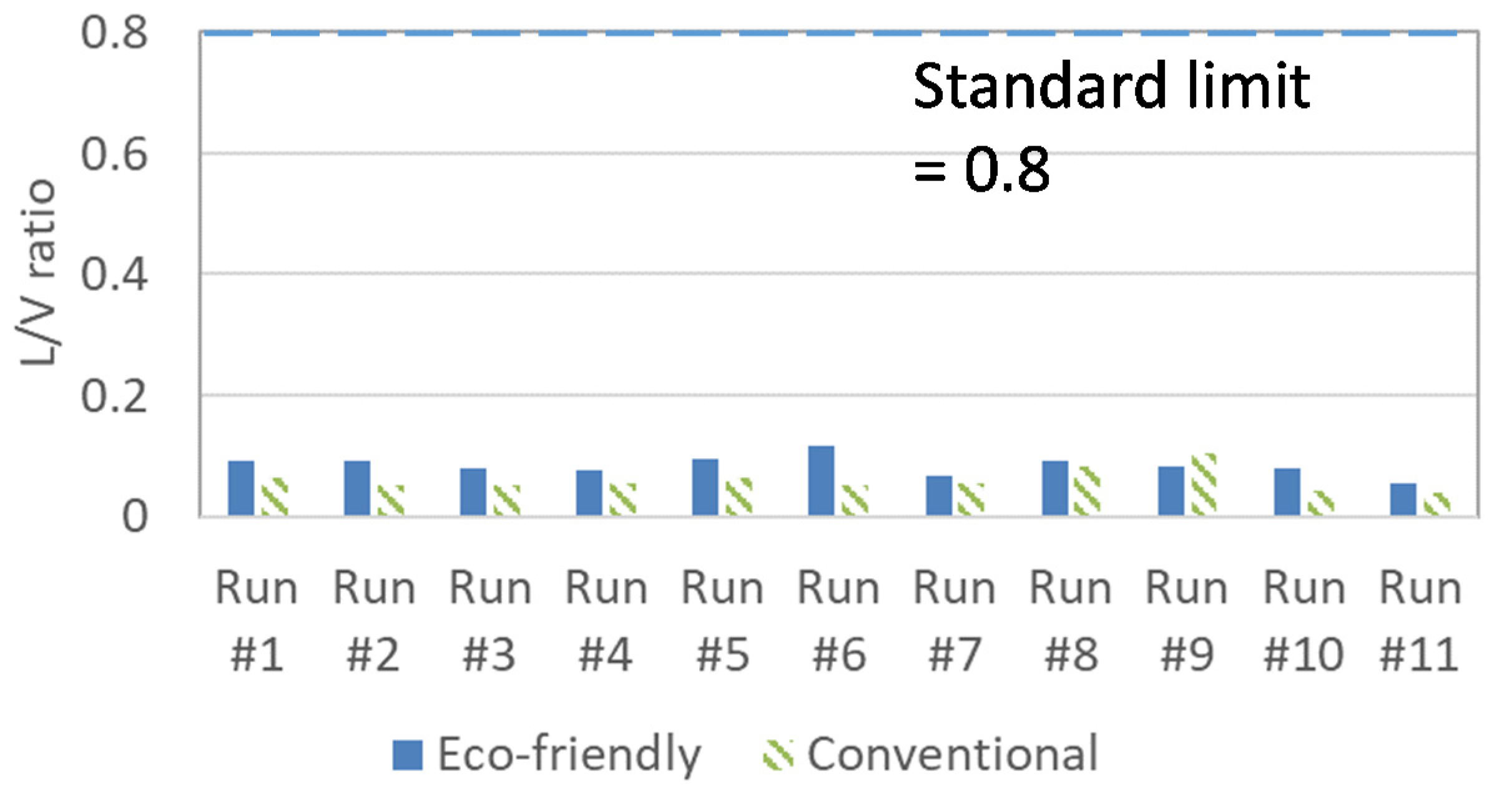

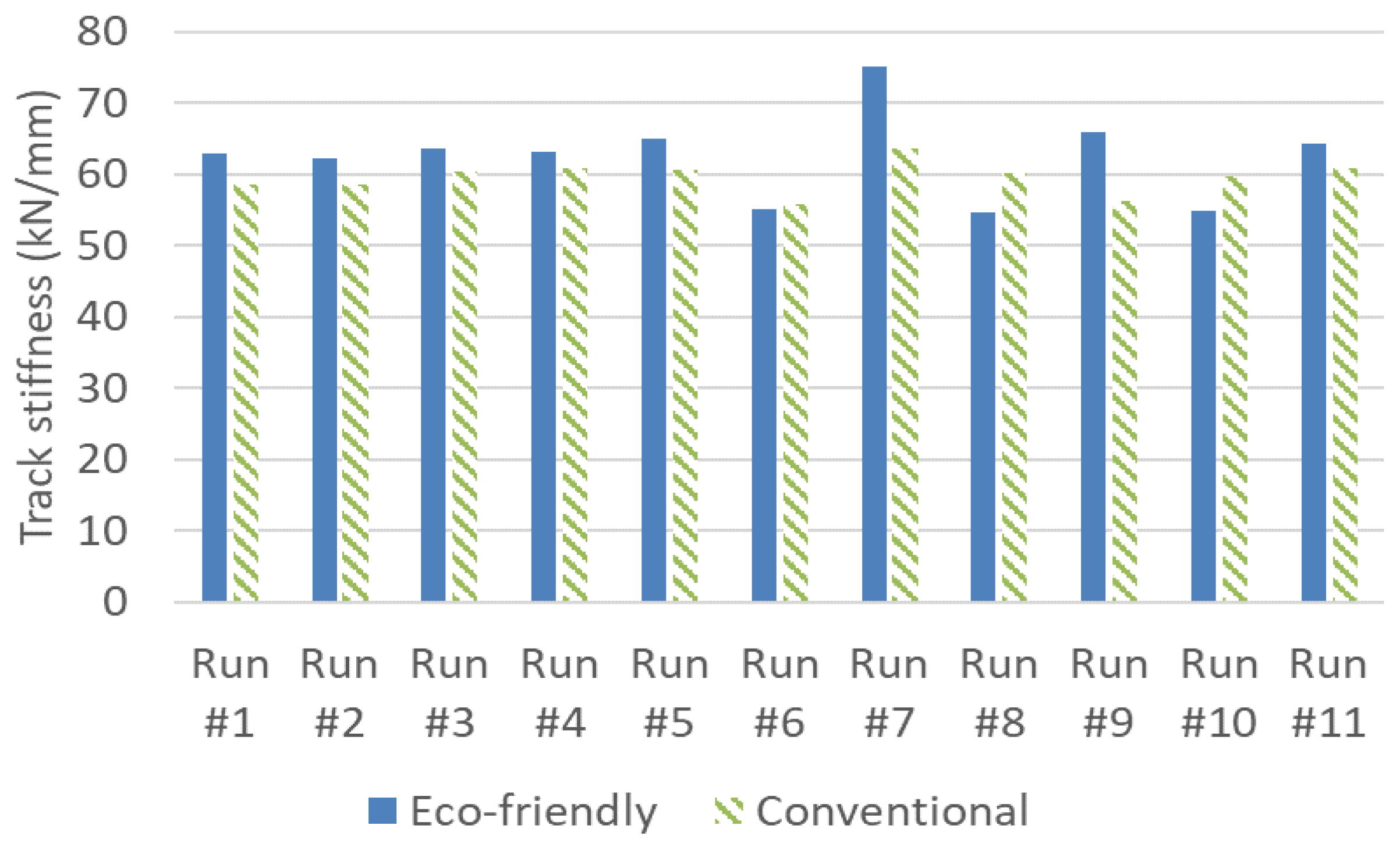

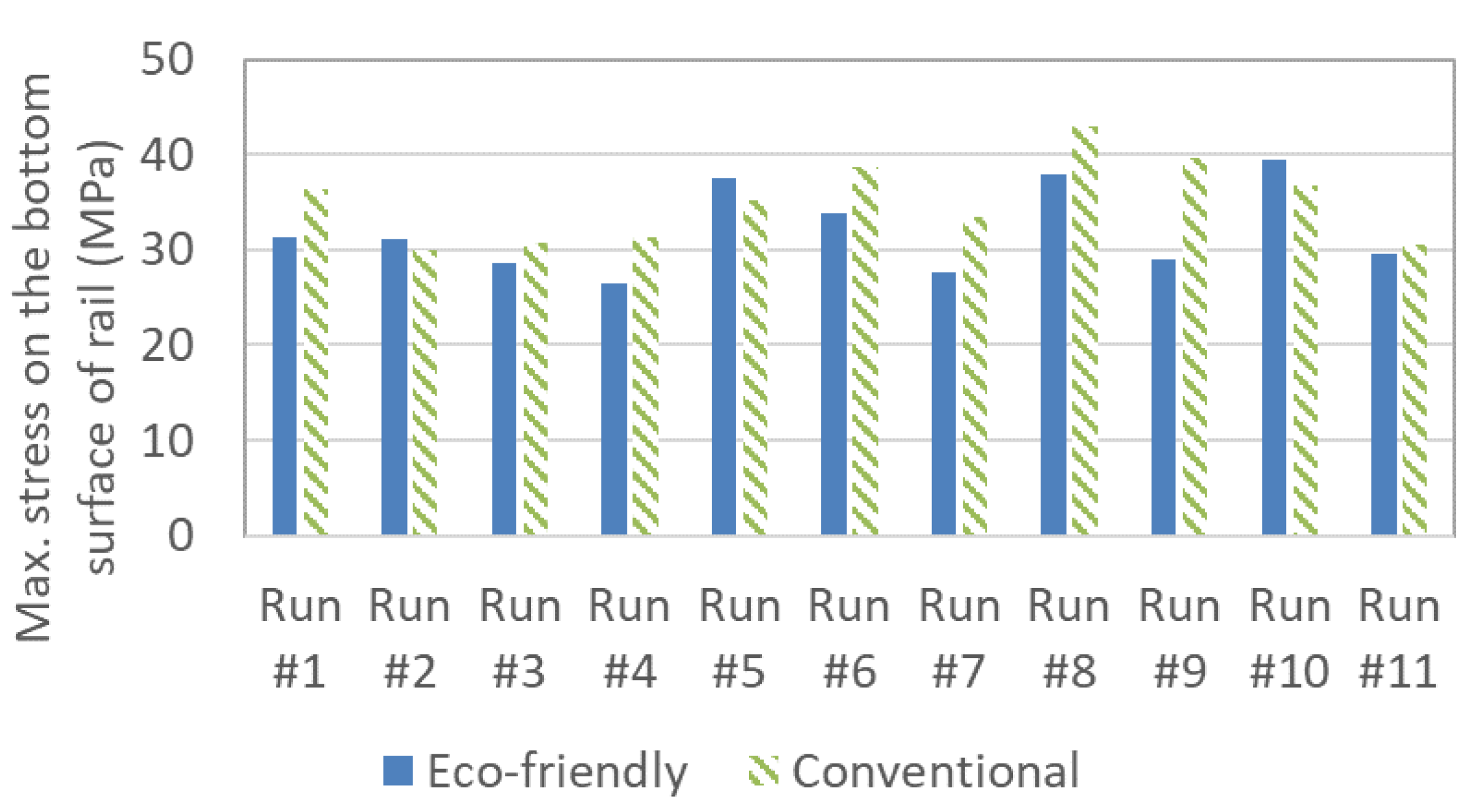
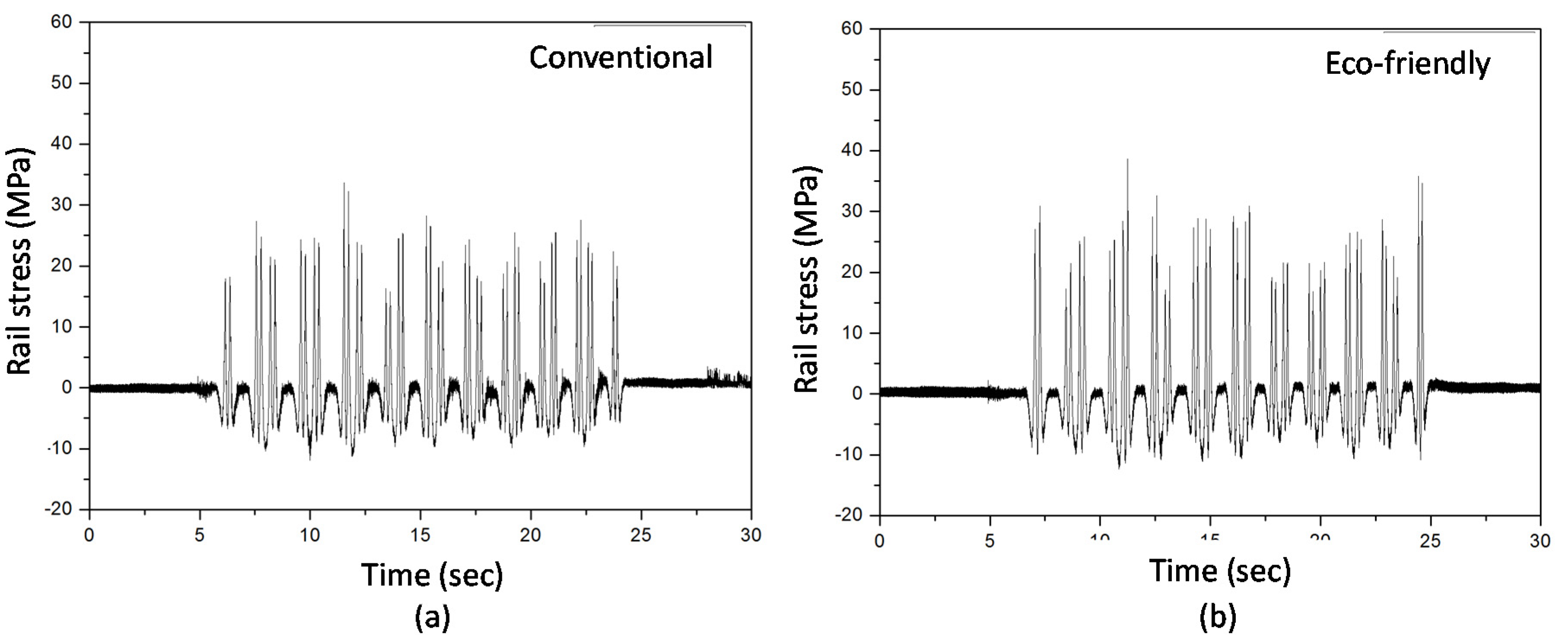
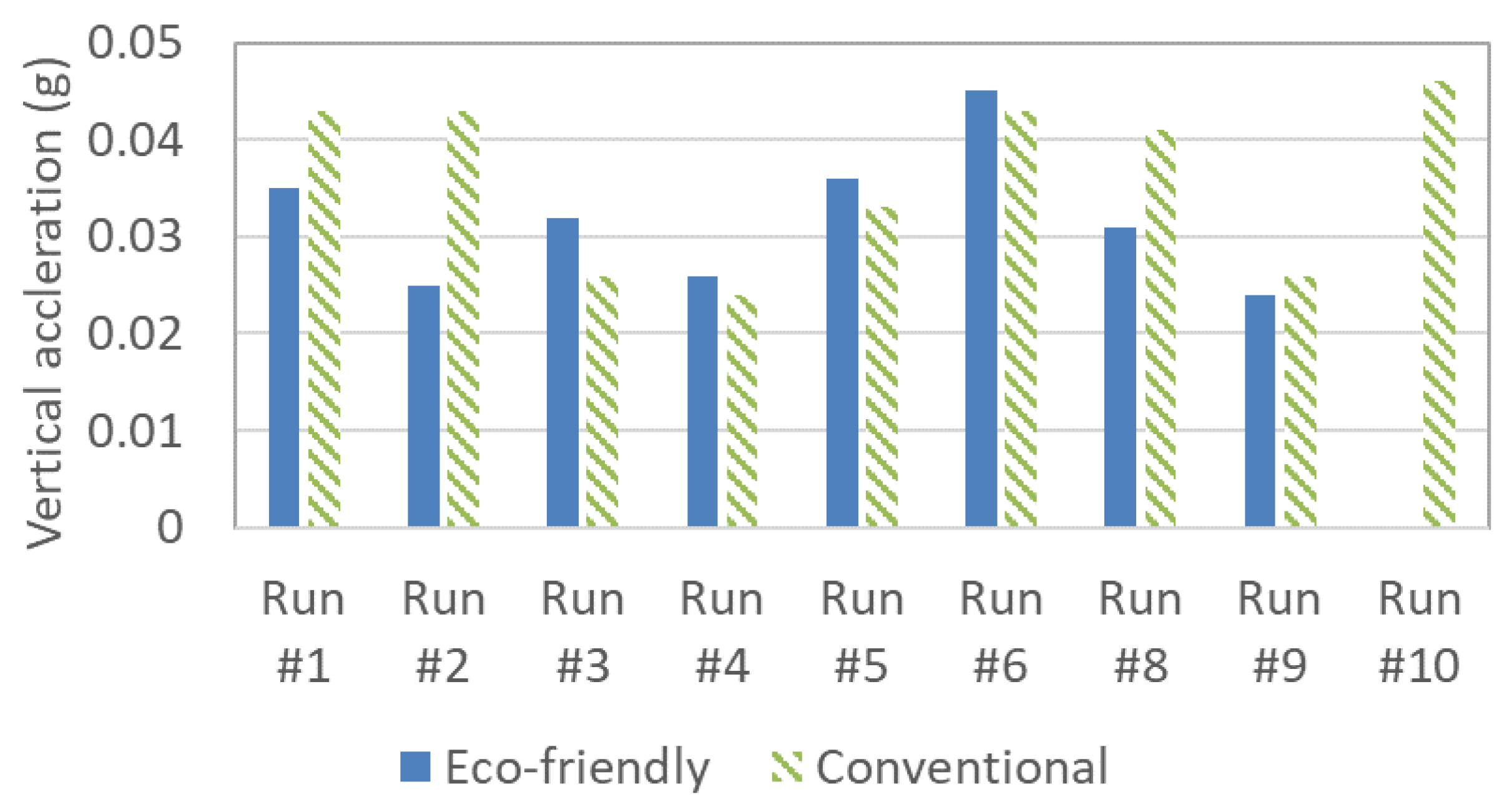


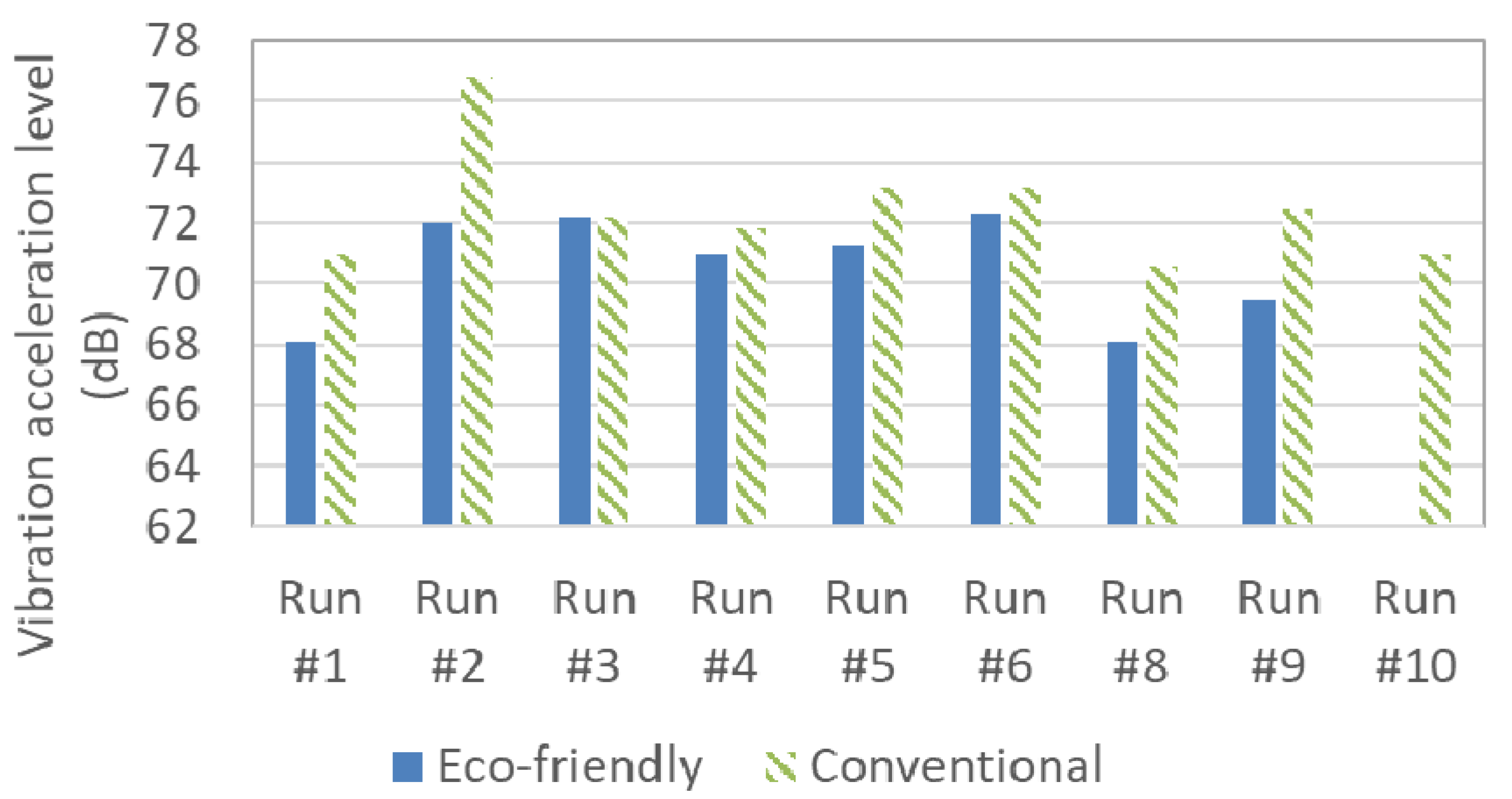
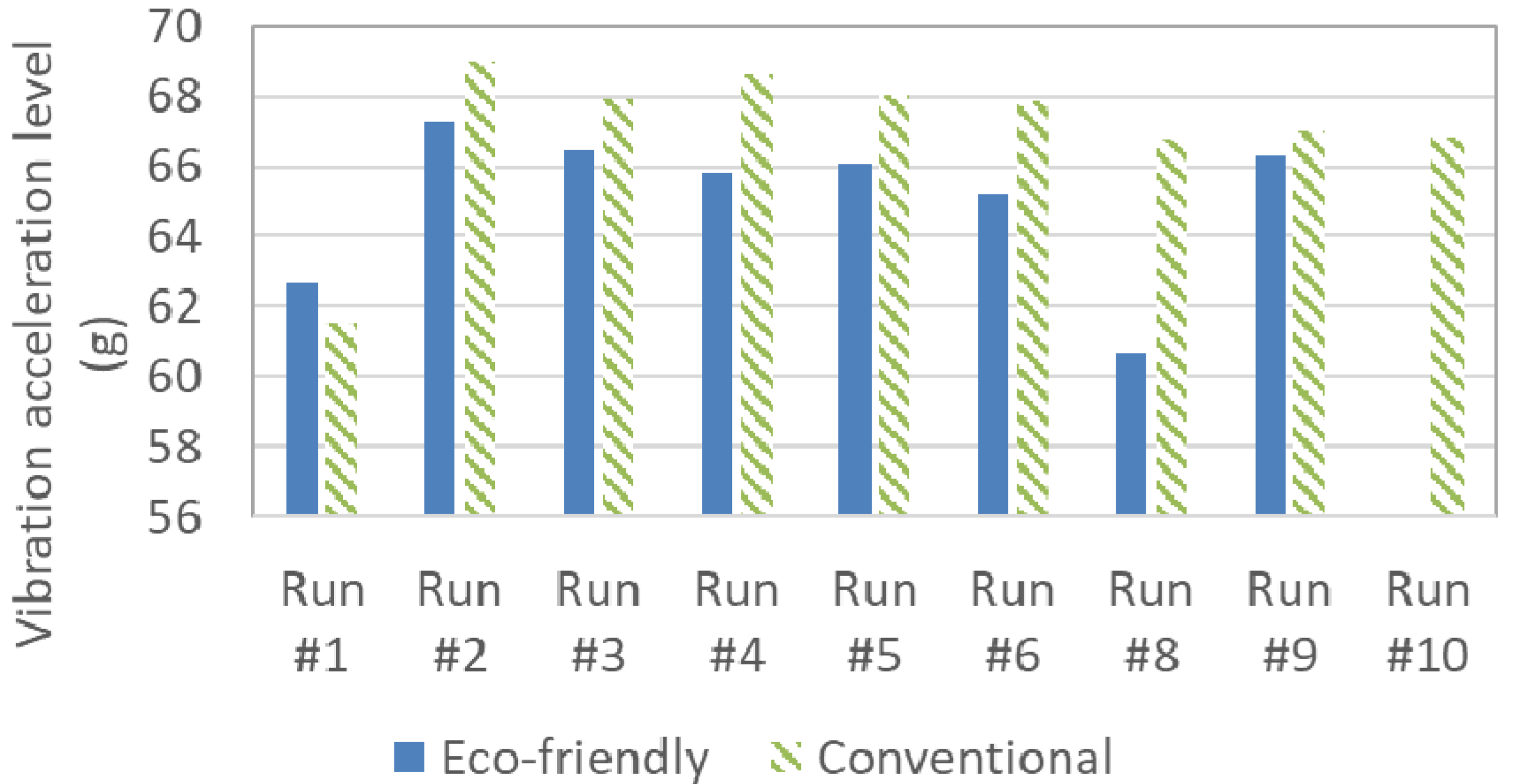
| Speed (km/h) | Speed (km/h) | ||
|---|---|---|---|
| Run #1 | 39 | Run #7 | 41 |
| Run #2 | 35 | Run #8 | 39 |
| Run #3 | 36 | Run #9 | 31 |
| Run #4 | 36 | Run #10 | 47 |
| Run #5 | 38 | Run #11 | 37 |
| Run #6 | 42 | Average Speed | 38.3 |
© 2020 by the authors. Licensee MDPI, Basel, Switzerland. This article is an open access article distributed under the terms and conditions of the Creative Commons Attribution (CC BY) license (http://creativecommons.org/licenses/by/4.0/).
Share and Cite
Koh, T.; Shin, M. Field Tests on Eco-Friendly Railway Precast Concrete Slab. Appl. Sci. 2020, 10, 4140. https://doi.org/10.3390/app10124140
Koh T, Shin M. Field Tests on Eco-Friendly Railway Precast Concrete Slab. Applied Sciences. 2020; 10(12):4140. https://doi.org/10.3390/app10124140
Chicago/Turabian StyleKoh, Taehoon, and Moochul Shin. 2020. "Field Tests on Eco-Friendly Railway Precast Concrete Slab" Applied Sciences 10, no. 12: 4140. https://doi.org/10.3390/app10124140





